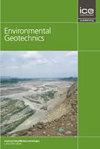用机器学习方法预测钠基膨润土gcl的导电性
IF 2.2
4区 工程技术
Q3 ENGINEERING, GEOLOGICAL
引用次数: 2
摘要
使用六种机器学习方法(线性回归、逻辑回归、XGBoost、SVM、KNN和ANN)来预测/分类传统钠-膨润土土工合成粘土衬垫(Na-B GCLs)对盐溶液或渗滤液的水力传导率。数据从文献中收集,随机分为两组,80%的数据用于训练机器学习模型,其余20%用于评估模型性能。已知影响Na-B gcl的水力导电性的特征(例如,gcl的单位面积质量、一价和二价阳离子、离子强度(I)、一价和二价阳离子的相对丰度(RMD)、膨胀指数和有效应力)被用来预测/分类Na-B gcl的水力导电性。对不同特征组合对应的7个子集进行对比分析,通过交叉验证确定最佳模型。结果表明,在所有回归和分类分析的特征子集上,XGBoost在所有方法中始终具有最佳性能。子集4以膨胀指数、I、RMD、I2·RMD、单价阳离子、二价阳离子、有效应力和单位面积质量为特征,在样本外测试的回归分析(R2=0.826)和分类分析(准确率=0.887)中都优于其他6个子集。本文章由计算机程序翻译,如有差异,请以英文原文为准。
Prediction of hydraulic conductivity of sodium bentonite GCLs by machine learning approaches
Six machine learning methods (Linear Regression, Logistic Regression, XGBoost, SVM, KNN,and ANN) were used to predict/classify hydraulic conductivity of conventional sodium-bentonite geosynthetic clay liners (Na-B GCLs) to saline solutions or leachates. Data were collected from literature and randomly divided into two groups, i.e., 80% of the data were used to train machine learning models and the rest 20% were applied to evaluate model performance. Features, that are known to affect the hydraulic conductivity of Na-B GCLs (e.g., mass per unit area of GCLs, monovalent and divalent cation, ionic strength (I), relative abundance of monovalent and divalent cations (RMD), swell index, and effective stress), were employed to predict/classify hydraulic conductivity of Na-B GCLs. Comparative analyses were conducted with seven Subsets corresponding to the combination of different features and the best model was determined via cross-validation. The results showed that XGBoost consistently had the best performance among all methods over all Subsets of feature for both regression and classification analyses. Subset 4, using swell index, I, RMD, I2·RMD, monovalent cation, divalent cation, effective stress, and mass per unit area as features, outperformed all other six Subsets in both regression analysis (R2=0.826) and classification analysis (Accuracy=0.887) in the out-of-sample tests.
求助全文
通过发布文献求助,成功后即可免费获取论文全文。
去求助
来源期刊

Environmental geotechnics
Environmental Science-Water Science and Technology
CiteScore
6.20
自引率
18.20%
发文量
53
期刊介绍:
In 21st century living, engineers and researchers need to deal with growing problems related to climate change, oil and water storage, handling, storage and disposal of toxic and hazardous wastes, remediation of contaminated sites, sustainable development and energy derived from the ground.
Environmental Geotechnics aims to disseminate knowledge and provides a fresh perspective regarding the basic concepts, theory, techniques and field applicability of innovative testing and analysis methodologies and engineering practices in geoenvironmental engineering.
The journal''s Editor in Chief is a Member of the Committee on Publication Ethics.
All relevant papers are carefully considered, vetted by a distinguished team of international experts and rapidly published. Full research papers, short communications and comprehensive review articles are published under the following broad subject categories:
geochemistry and geohydrology,
soil and rock physics, biological processes in soil, soil-atmosphere interaction,
electrical, electromagnetic and thermal characteristics of porous media,
waste management, utilization of wastes, multiphase science, landslide wasting,
soil and water conservation,
sensor development and applications,
the impact of climatic changes on geoenvironmental, geothermal/ground-source energy, carbon sequestration, oil and gas extraction techniques,
uncertainty, reliability and risk, monitoring and forensic geotechnics.
 求助内容:
求助内容: 应助结果提醒方式:
应助结果提醒方式:


